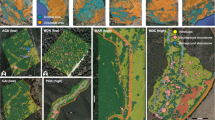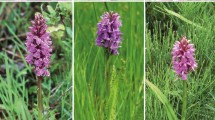Abstract
Delayed selfing has been considered the best-of-both-worlds response to pollinator unpredictability because it can provide reproductive assurance without decreasing outcrossing potential. According to this hypothesis, selfing rates in delayed selfing species should be highly variable in fluctuating pollinator environments. To test this prediction, as well to explore the consequences of delayed selfing on genetic patterns, we compared two sister species that grow in the high Andes of Chile: Schizanthus grahamii that exhibits delayed selfing and Schizanthus hookeri, which is self-compatible but requires pollinators for seed set. We estimated genetic diversity within and among five populations of each species using six shared microsatellites. Our results indicated that selfing rates in S. grahamii (range 0.07–0.81) were significantly more variable than in S. hookeri (range 0–0.26). The highest levels of selfing were found in the populations of S. grahamii located at highest altitudes (r = 0.78) and at northern margin range, where pollinators are probably more scarce. These populations also showed the lowest allelic richness and heterozygosity values. Southern populations of S. grahamii had mixed mating, and showed heterozygosity and diversity values close to those detected for S. hookeri along all the sampled range. Selfing in this species results from geitonogamy, and did not covary with altitude. Schizanthus grahamii showed greater population differentiation than S. hookeri. Overall, our results indicated that selfing rates were widely variable in S. grahamii, with some populations predominantly selfing and others showing mixed mating. This pattern may be associated with the strong fluctuations in pollinator service that typically occur in the high Andes of Chile.

Similar content being viewed by others
References
Aide TM (1986) The influence of wind and animal pollination on variation in outcrossing rates. Evolution 40:434–435
Arroyo MTK (1973) A taximetric study of infraspecific variation in autogamous Limnanthes floccosa (Limnanthaceae). Brittonia 25:177–191
Arroyo MTK, Armesto JJ, Primack R (1985) Community studies in pollination ecology in the high temperate Andes of Central Chile. II. Effect of temperature on visitation rates and pollination possibilities. Plant Syst Evol 149:187–203
Arroyo MTK, Muñoz S, Henríquez C, Till-Bottraud I, Pérez F (2006) Erratic pollination, high selfing levels and their correlates and consequences in an altitudinally widespread above tree-line species in the high Andes of Chile. Acta Oecol 30:248–257
Awadalla P, Ritland K (1997) Microsatellite variation and evolution in the Mimulus guttatus species complex with contrasting mating systems. Mol Biol Evol 14:1023–1034
Barrett SCH (2003) Mating strategies in flowering plants: the outcrossing-selfing paradigm. Philos Trans R Soc B 358:991–1004
Belkhir K, Borsa P, Chikhi L, Raufaste N, Bonhomme F (2001) GENETIX 4.02 Logiciel sous. Windows TM pour la génétique des populations, Laboratoire Génome, Populations, interactions, CNRS UMR 5000. Montpellier
Bingham RA, Orthner AR (1998) Efficient pollination of alpine plants. Nature 391:238–239
Bingham RA, Ranker TA (2000) Genetic diversity in alpine and foothill populations of Campanula rotundifolia (Campanulaceae). Int J Plant Sci 161:403–411
Bliss LC (1962) Adaptations of arctic and alpine plants to environmental conditions. Arctic 15:117–144
Busch JW (2005) The evolution of self-compatibility in geographically peripheral populations of Leavenworthia alabamica (Brassicaceae). Am J Bot 92:1503–1512
Carlson JE (2008) Hummingbirds responses to gender-biased nectar production: are nectar biases maintained by natural or sexual selection? Proc Biol Sci 275:1717–1746
Charlesworth D, Charlesworth B (1995) Quantitative genetics in plants: the effect of the breeding system on genetic variability. Evolution 49:911–920
Charlesworth D, Wright SI (2001) Breeding systems and genome evolution. Curr Opin Genet Dev 11:685–690
Charlesworth B, Morgan MT, Charlesworth D (1993) The effect of deleterious mutations on neutral molecular variation. Genetics 134:1289–1303
David P, Pujol B, Viard F, Castella V, Goudet J (2007) Reliable selfing rate estimates from imperfect population genetic data. Mol Ecol 16:2474–2487
Dvorak J, Luo MC, Yang ZL (1998) Restriction fragment length polymorphism and divergence in the genomic regions of high and low recombination in self-fertilizing and cross-fertilizing Aegilops species. Genetics 148:423–434
Ellstrand NC, Elam DR (1993) Population genetic consequences of small population size: implications for plant conservation. Annu Rev Ecol Syst 24:217–242
Excoffier L, Smouse PE, Quattro JM (1992) Analysis of molecular variance inferred from metric distances among DNA haplotypes: application to human mitochondrial DNA restriction data. Genetics 131:479–491
Fenster CB, Ritland K (1992) Chloroplast DNA and isozyme diversity in two Mimulus species (Scrophulariaceae) with contrasting mating systems. Am J Bot 79:1440–1447
Glémin S, Bazin E, Charlesworth D (2006) Impact of mating systems on patterns of sequence polymorphism in flowering plants. Proc Biol Sci 273:3011–3019
Goodwillie C, Kalisz S, Eckert CC (2005) The evolutionary enigma of mixed mating in plants. Annu Rev Ecol Syst 36:47–79
Grau J, Grönbach E (1984) Untersuchungen zur variabilität in der gattung Schizanthus (Solanaceae). Mitteilungen der Botanischen Staatssammlung München 20:111–203
Hamrick JL, Godt MJW (1996) Effect of life history traits on genetic diversity in plant species. Philos Trans R Soc B 351:1291–1298
Hodgins KA, Barrett SC (2006) Mating patterns and demography in the tristylous daffodil Narcissus triandrus. Heredity 96:262–270
Holsinger KE (1988) Inbreeding depression doesn’t matter: the genetic basis of mating system evolution. Evolution 42:1235–1244
Igic B, Kohn JR (2006) The distribution of plant mating systems: study bias against obligately outcrossing species. Evolution 60:1098–1103
Ingvarsson PK (2002) A metapopulation perspective on genetic diversity and differentiation in partially self-fertilizing plants. Evolution 56:2368–2373
Iwasa Y (1990) Evolution of the selfing rate and resource allocation models. Plant Species Biol 5:19–30
Jarne P, Auld JR (2006) Animals mix it up too: the distribution of self-fertilization among hermaphroditic animals. Evolution 60:1816–1824
Jarne P, David P (2008) Quantifying inbreeding in natural populations of hermaphroditic organisms. Heredity 100:431–439
Kalisz S, Vogler DW (2003) Benefits of autonomous selfing under unpredictable pollinator environments. Ecology 84:2928–2942
Kalisz S, Vogler DW, Hanley KM (2004) Context-dependent autonomous self-fertilization yields reproductive assurance and mixed mating. Nature 430:884–887
Kropf M, Renner SS (2008) Pollinator-mediated selfing in two deceptive orchids and a review of pollinium tracking studies addressing geitonogamy. Oecologia 155:497–508
Lande R, Schemske DW (1985) The evolution of self-fertilization and inbreeding depression in plants I genetic models. Evolution 39:24–40
Liu F, Zhang L, Charlesworth D (1998) Genetic diversity in Leavenworthia populations with different inbreeding levels. Proc Biol Sci 265:293–301
Lloyd DG (1979) Some reproductive factors affecting the selection of self-fertilization in plants. Am Nat 113:67–79
Lloyd DG (1992) Self- and cross-fertilization in plants II. The selection of self-fertilization. Int J Plant Sci 153:370–380
Maad J, Reinhammar LG (2004) Incidence of geitonogamy differs between two populations in the hawkmoth-pollinated Platanthera bifolia (Orchidaceae). Can J Bot 82:1586–1593
Mable BK, Adam K (2007) Patterns of genetic diversity in outcrossing and selfing populations of Arabidopsis lyrata. Mol Ecol 16:3565–3580
Mimura M, Aitken SN (2007) Increased selfing and decreased effective pollen donor number in peripheral relative to central populations in Picea sitchensis (Pinaceae). Am J Bot 94:991–998
Nybom H (2004) Comparison of different nuclear DNA markers for estimating intraspecific genetic diversity in plants. Mol Ecol 13:1143–1155
Peakall R, Smouse PE (2006) GenAlEx 6: genetic analysis in excel population genetic software for teaching and research. Mol Ecol Notes 6:288–295
Pérez F (2011) Discordant patterns of morphological and genetic divergence in the closely related species Schizanthus hookeri and S grahamii (Solanaceae). Plant Syst Evol 293:197–205
Pérez F, Arroyo MTK, Medel R, Hershkovitz M (2006) Ancestral reconstruction of flower morphology and pollination systems in Schizanthus. Am J Bot 93:1029–1038
Pérez F, Arroyo MTK, Medel R (2009) Evolution of autonomous selfing accompanies increased specialization in the pollination system of Schizanthus (Solanaceae). Am J Bot 96:1168–1176
Pérez F, Spencer P, Cienfuegos A, Suárez L (2011) Microsatellite markers for the high Andean species Schizanthus hookeri and S grahamii (Solanaceae). Am J Bot 98:e114–e118
Porcher E, Lande R (2005) Reproductive compensation in the evolution of plant mating systems. New Phytol 166:673–684
Rahel L, Graf R, Gugerli F, Landergott U, Holderegger R (2010) Lower selfing rate at higher altitudes in the alpine plant Eritrichium nanum (Boraginaceae). Am J Bot 97:899–901
Ritland K (1984) The effective proportion of self-fertilization with consanguineous matings in inbred populations. Genetics 106:139–152
Sakai S (1995) Evolutionarily stable selfing rates of hermaphroditic plants in competing and delayed selfing modes with allocation to attractive structures. Evolution 49:557–564
Schoen DJ, Brown AH (1991) Intraspecific variation in population gene diversity and effective population size correlates with the mating system in plants. PNAS 88:4494–4497
Schoen DJ, Lloyd DG (1992) Self- and cross-fertilization in plants III methods for studying modes and functional aspects of self fertilization. Int J Plant Sci 153:381–393
Sokal RR, Rohlf FJ (1995) Biometry: the principles and practice of statistics in biological research. W H Freeman and Co, USA
Sweigart AL, Mason A, Willis JH (2007) Natural variation for a hybrid incompatibility between two species of Mimulus. Evolution 61:141–151
Utelli A, Roy BA (2008) Pollinator abundance and behavior on Acontinum lycoctonum (Ranunculaceae): an analysis of the quantity and quality components of pollinatin. Oikos 89:461–470
Uyenoyama MK, Holsinger KE, Waller DM (1993) Ecological and genetic factors directing the evolution of self-fertilization. Oxf Surv Evol Biol 9:327–381
Vaughton G, Ramsey M (2010) Pollinator-mediated selfing erodes the flexibility of the best-of-both-worlds mating strategy in Bulbine vagans. Funct Ecol 24:374–382
Vogler DW, Kalisz S (2001) Sex among the flowers: the distribution of plant mating systems. Evolution 55:202–28705
Weir BS, Cockerham CC (1984) Estimating F-statistics for the analysis of population structure. Evolution 38:1358–1370
Williams CF, Ruvinsky J, Scott PE, Hews DK (2001) Pollination, breeding system, and genetic structure in two sympatric Delphinium (Ranunculaceae) species. Am J Bot 88:1623–1633
Wright S (1969) Evolution and the genetics of populations. The University of Chicago Press, USA
Yan J, Chu HJ, Wang HC, Li JQ, Sang T (2009) Population genetic structure of two Medicago species shaped by distinct life form, mating system and seed dispersal. Ann Bot 103:825–834
Acknowledgments
We thank the financial support of FONDECYT 11085018 and Millennium Scientific Initiative (Mideplan, Chile) P05-002-F-ICM and Programa de Financiamiento Basal de Conicyt (PFB-23).
Author information
Authors and Affiliations
Corresponding author
Appendix
Appendix
See Table 4.
Rights and permissions
About this article
Cite this article
Pérez, F., León, C. & Muñoz, T. How variable is delayed selfing in a fluctuating pollinator environment? A comparison between a delayed selfing and a pollinator-dependent Schizanthus species of the high Andes. Evol Ecol 27, 911–922 (2013). https://doi.org/10.1007/s10682-012-9612-0
Received:
Accepted:
Published:
Issue Date:
DOI: https://doi.org/10.1007/s10682-012-9612-0




